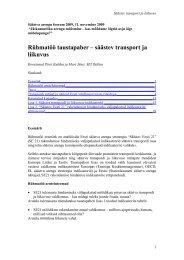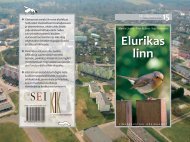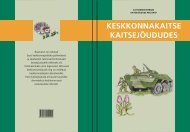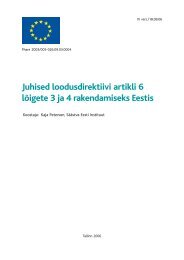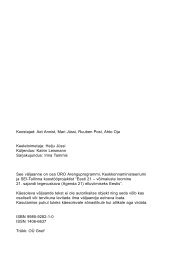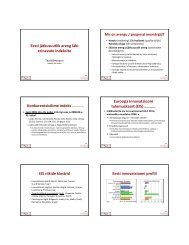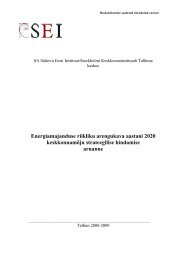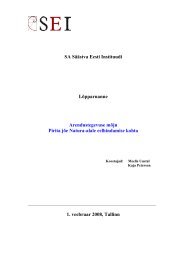Combined biological treatment of high-sulphate ... - ResearchGate
Combined biological treatment of high-sulphate ... - ResearchGate
Combined biological treatment of high-sulphate ... - ResearchGate
Create successful ePaper yourself
Turn your PDF publications into a flip-book with our unique Google optimized e-Paper software.
<strong>Combined</strong> <strong>biological</strong> <strong>treatment</strong> <strong>of</strong> <strong>high</strong>-<strong>sulphate</strong> wastewater from<br />
yeast production<br />
S. Zub 1 , T. Kurissoo 2 , A. Menert 3 & V. Blonskaja 4<br />
Water and Environment Journal. Print ISSN 1747-6585<br />
1 Salutaguse Yeast Factory, Kohila, Raplamaa, Estonia; 2 BimKemi Eesti AS, Tallinn, Estonia; 3 Department <strong>of</strong> Chemistry, Tallinn University <strong>of</strong> Technology,<br />
Tallinn, Estonia; and 4 Department <strong>of</strong> Environmental Engineering, Tallinn University <strong>of</strong> Technology, Tallinn, Estonia<br />
Keywords<br />
anaerobic; anoxic; baker’s yeast; betaine<br />
(trimethylglycine); sludge; <strong>sulphate</strong>-rich<br />
wastewater.<br />
Correspondence<br />
A. Menert, Department <strong>of</strong> Chemistry, Tallinn<br />
University <strong>of</strong> Technology, Ehitajate tee 5,<br />
19086 Tallinn, Estonia. Email:<br />
amenert@cc.ttu.ee<br />
doi:10.1111/j.1747-6593.2007.00097.x<br />
Abstract<br />
The wastewater from baker’s yeast production contains above-average concentrations<br />
<strong>of</strong> organic pollutants (25 000 mg/L total chemical oxygen demand,<br />
TCOD), nutrients (1500 mg/L N tot , 100 mg/L P tot ) and <strong>sulphate</strong> (2900 mg/L<br />
2<br />
SO 4 ). Baker’s yeast wastewater with a flow rate <strong>of</strong> 190 m 3 /day was treated in<br />
a mesophilic anaerobic/anoxic continuous stirred tank reactor (CSTR) system.<br />
At the expense <strong>of</strong> the reduction <strong>of</strong> trimethylglycine (or betaine-component <strong>of</strong><br />
sugar-beet molasses) to other nitrogen-containing compounds, it was possible<br />
to re-oxidize the sulphides to elemental sulphur, remove them from the<br />
wastewater and increase biogas production. Therefore, the average removal<br />
2<br />
efficiency in the anaerobic/anoxic system was 79% by TCOD, 100% by SO 4<br />
in which the concentration <strong>of</strong> sulphides in the effluent did not exceed 50 mg/L.<br />
The application <strong>of</strong> this combined anaerobic/anoxic system to a full-scale<br />
<strong>treatment</strong> plant supported biogas production up to 1300 m 3 /day, and the<br />
purification <strong>of</strong> wastewater was feasible without the use <strong>of</strong> granular sludge.<br />
List <strong>of</strong> symbols<br />
BOD <strong>biological</strong> oxygen demand (mg/L)<br />
COD chemical oxygen demand (mg/L)<br />
DS dry solids (%)<br />
HELCOM Helsinki Commission or Baltic Marine Environment Protection<br />
Commission<br />
N tot total concentration <strong>of</strong> nitrogen (mg/L)<br />
P tot total concentration <strong>of</strong> phosphorus (mg/L)<br />
SBR sequenced batch reactor<br />
SCOD solubilized chemical oxygen demand (mg/L)<br />
SRB <strong>sulphate</strong>-reducing bacteria<br />
SS suspended solids (mg/L)<br />
t time (h)<br />
TCOD total chemical oxygen demand (mg/L)<br />
TKN total Kjeldahl nitrogen (mg/L)<br />
UASB up-flow anaerobic sludge blanket reactor<br />
VFAs concentration <strong>of</strong> volatile fatty acids (meq/dm 3 )<br />
VSS volatile suspended solids (mg/L)<br />
WWTP wastewater <strong>treatment</strong> plant<br />
Introduction<br />
Sources <strong>of</strong> <strong>sulphate</strong> and sulphide pollution<br />
Many industrial processes, including the food and fermentation<br />
industries, generate wastewaters containing<br />
<strong>high</strong> levels <strong>of</strong> organic matter and <strong>sulphate</strong>. Yeast industry<br />
wastewater contains low levels <strong>of</strong> readily degradable<br />
sugars and acids and <strong>high</strong> levels <strong>of</strong> trimethylglycine and<br />
<strong>sulphate</strong>. Sulphate-reducing bacteria (SRB) compete with<br />
methane-producing micro-organisms for the available<br />
organic carbon, resulting in the formation <strong>of</strong> hydrogen<br />
sulphide. When treating <strong>high</strong>-<strong>sulphate</strong> wastewater, <strong>high</strong><br />
concentrations <strong>of</strong> sulphur compounds hinder wastewater<br />
<strong>treatment</strong> and the production <strong>of</strong> methane gas. This phenomenon<br />
results from the micro<strong>biological</strong> reduction <strong>of</strong><br />
<strong>sulphate</strong>s into sulphides. The stability <strong>of</strong> the <strong>treatment</strong><br />
process is dependent on the pH value as well as the<br />
concentration <strong>of</strong> the sulphides formed. Sulphides formed<br />
during the <strong>treatment</strong> process inhibit the growth <strong>of</strong> methanogens<br />
as well as the SRB in the pH range <strong>of</strong> 7.2–8.5<br />
(O’Flaherty et al. 1998).<br />
274<br />
Water and Environment Journal 22 (2008) 274–286<br />
c 2008 The Authors. Journal compilation c 2008 CIWEM.
S. Zub et al.<br />
Treatment <strong>of</strong> <strong>high</strong>-<strong>sulphate</strong> wastewater from yeast production<br />
Strategies to avoid <strong>high</strong> sulphide concentrations<br />
in wastewater<br />
The dilution <strong>of</strong> wastewater is an efficient method for the<br />
reduction <strong>of</strong> pollutant concentrations but it is not consistent<br />
with environmental protection strategies <strong>of</strong> the<br />
HELCOM (Helsinki Commission or Baltic Marine Environment<br />
Protection Commission) (Versprille 2000). The HEL-<br />
COM convention contracted in 1974 for protection <strong>of</strong> the<br />
marine environment <strong>of</strong> the Baltic Sea Area includes tasks<br />
that cannot effectively be accomplished by national<br />
efforts alone but by close regional co-operation. One <strong>of</strong><br />
its main tasks is to restrict pollution from land-based<br />
sources to the sea by point or diffuse inputs from all<br />
sources on land reaching the sea waterborne, airborne or<br />
directly from the coast (http://www.helcom.fi/stc/files/<br />
Convention/Conv0704.pdf).<br />
Fox & Venkatasubbiah (1996) and Janssen et al. (1997)<br />
found that it is also possible to remove the hydrogen<br />
sulphide produced in the anaerobic reactor from <strong>sulphate</strong><br />
by partly oxidizing it into elemental sulphur. This process<br />
can be performed in an anoxic reactor where the concentration<br />
<strong>of</strong> oxygen is below 0.1 mg O 2 /L. The elemental<br />
sulphur formed can be removed in the sedimentation<br />
tank. The wastewater circulates from the anaerobic<br />
reactor to the subsequent aerobic reactor and from that<br />
point back to the anaerobic reactor. This method enabled<br />
95% removal <strong>of</strong> the <strong>sulphate</strong>, and the residual concentration<br />
<strong>of</strong> sulphides in the outlet <strong>of</strong> the <strong>treatment</strong><br />
system was below 20 mg/L, while also facilitating<br />
stable pH conditions. In the Chinese patent<br />
N11144782, 1997, the removal <strong>of</strong> sulphides from an<br />
anaerobic reactor has been solved by feeding the reactor<br />
with a controlled concentration <strong>of</strong> O 2 or air (Shan &<br />
Xiong 1997). A similar method has also been used in<br />
the Netherlands (Lens et al. 2000) and United States<br />
(Zitomer & Shrout 2000) without observing any<br />
inhibiting effect on the methanogens. Industrial (Buisman<br />
1996) as well as laboratory experiments have shown<br />
that sulphide-containing wastewater leaving anaerobic<br />
reactors does not inhibit the processes in the aerobic<br />
reactor.<br />
Biological methods for the removal <strong>of</strong> sulphurcontaining<br />
compounds from wastewater<br />
In the case <strong>of</strong> <strong>biological</strong> <strong>treatment</strong>, <strong>sulphate</strong>, sulphite and<br />
other sulphur compounds are reduced in an anaerobic<br />
step to sulphide, which in turn can be oxidized to<br />
elemental sulphur by way <strong>of</strong> limited oxidation (Buisman<br />
1996; Lens et al. 1998). For reducing sulphur compounds<br />
to sulphide, an electron donor is necessary, as follows<br />
from the reaction:<br />
SO 2 4 þ 5H 2 O þ 8e ! HS þ 9HO : ð1Þ<br />
Biotechnological processes for sulphide removal consist<br />
in the conversion <strong>of</strong> sulphide into elemental sulphur by<br />
colourless sulphur bacteria (Thiobacilli), (Buisman et al.<br />
1990; Janssen et al. 1997) according to the following<br />
reaction:<br />
2HS þ O 2 ! 2S 0 þ 2OH ; ð2Þ<br />
or by genera <strong>of</strong> anaerobic photosynthetic bacteria from<br />
the families Chlorobiaceae and Chromaticeae that catalyse<br />
the photosynthetic van Niel reaction (Henshaw et al.<br />
1998):<br />
2n H 2 S þ n CO 2 ! hn 2n S 0 þðCH 2 OÞn þ n H 2 O: ð3Þ<br />
In the latter case, light radiated to a photosynthetic<br />
reactor is coupled to the conversion <strong>of</strong> sulphide to elemental<br />
sulphur using the reverse citric acid cycle (Arnon<br />
cycle). The advantage <strong>of</strong> such a method is that only small<br />
waste streams remain because the sulphur, that is, formed<br />
can be reused. However, the disadvantage is that, especially<br />
when the effluent contains little organic matter,<br />
electron donors (methanol, ethanol, glucose and other<br />
saccharides, organic acids, H 2 and CO) have to be added in<br />
order to provide sufficient reducing equivalents for the<br />
SRB. This, as a result, increases the costs <strong>of</strong> this method<br />
substantially (Buisman 1996). Organic compounds that<br />
have more than two carbon atoms that degrade under<br />
anaerobic conditions give H 2 and acetate. H 2 can be used<br />
as an electron donor for the reduction <strong>of</strong> <strong>sulphate</strong> and<br />
sulphite.<br />
Role <strong>of</strong> trimethylglycine in anaerobic processes<br />
Anaerobic granular sludge bed technology with upwardflow<br />
anaerobic sludge blanket (UASB) reactors is used for<br />
<strong>high</strong>-rate anaerobic <strong>treatment</strong> <strong>of</strong> wastewater. However, the<br />
UASB reactor is <strong>of</strong>ten inapplicable for the <strong>treatment</strong> <strong>of</strong> <strong>high</strong><br />
<strong>sulphate</strong>-containing wastewaters (Blonskaja et al. 2001).<br />
The instability and increased washout <strong>of</strong> sludge granules<br />
observed can be explained by the fact that under stress<br />
conditions, all energy gained by bacteria from dissimilation<br />
is used for the generation <strong>of</strong> metabolic products, and not for<br />
the growth <strong>of</strong> cells (Weijma et al. 2000).<br />
Sugar-beet molasses used as a growth medium for yeast<br />
contains large amounts [up to 6% dry solids (DS)] <strong>of</strong> betaine<br />
also known as N,N,N-trimethyl glycine, a soluble nitrogenous<br />
compound. Molasses is used as a substrate in a wide<br />
range <strong>of</strong> industrial fermentations, for example, alcohol, acid<br />
and yeast cell production. Trimethylglycine is not significantly<br />
consumed during these fermentations, passes the<br />
Water and Environment Journal 22 (2008) 274–286 c 2008 The Authors. Journal compilation c 2008 CIWEM. 275
Treatment <strong>of</strong> <strong>high</strong>-<strong>sulphate</strong> wastewater from yeast production<br />
S. Zub et al.<br />
subsequent processing stages and becomes a significant<br />
constituent <strong>of</strong> wastewater (Thalasso et al. 1999).<br />
Trimethylglycine is a compatible solute, which is able to<br />
restore and maintain the osmotic balance <strong>of</strong> living cells. It is<br />
synthesized and accumulated in response to abiotic stress.<br />
Trimethylglycine also acts as a methyl group donor and has<br />
a number <strong>of</strong> important applications including its use as a<br />
feed additive (Nyyssola et al. 2000). In anaerobic <strong>treatment</strong><br />
plants, trimethylglycine can be nearly entirely degraded by<br />
a multistep process with the nitrogen-containing intermediates<br />
trimethylamine and other methylated amines,<br />
which are further degraded by methanogens, yielding<br />
CO 2 , ammonium and methane (Thalasso et al. 1999). The<br />
ammonium formed buffers the <strong>treatment</strong> system and<br />
enables its stable function. The cleavage <strong>of</strong> trimethylglycine<br />
into trimethylamine and acetate is characteristic <strong>of</strong> some<br />
halophilic fermentative bacteria (Moune et al. 1999).<br />
2:5 trimethylglycine þ 4:04 H 2 !<br />
þ 2-propanol þ 2:5 trimethylamine<br />
þ 0:95 acetate þ 0:1 CO 2 þ 1:9 H 2 O;<br />
ð4Þ<br />
trimethylglycine þ 1:32 serine þ H 2 O !<br />
trimethylamine þ 2 acetate þ 1:32 CO 2 þ 1:32 NH 3 :<br />
ð5Þ<br />
A similar cleavage mechanism for trimethylglycine<br />
under anaerobic conditions has also been reported for<br />
Clostridium sporogenes (Naumann et al. 1983; von Zumbusch<br />
et al. 1994) while the fermentation products <strong>of</strong><br />
Eubacterium limosum are N,N-dimethylglycine, acetic acid<br />
and butyric acid (Müller et al. 1981; von Zumbusch et al.<br />
1994). The acetate and trimethylamine can be readily<br />
used as carbon and energy sources by acetotrophic<br />
(e.g. Methanobacterium soehngenii) and methylotrophic<br />
methanogens (e.g. Methanosarcina barkeri), respectively<br />
(Tchobanoglous & Burton 1991):<br />
CH 3 COOH ! CH 4 þ CO 2 ;<br />
4ðCH 3 Þ 3<br />
N þ 12 H 2 O ! 9CH 4 þ 3CO 2 þ 6H 2 O<br />
þ 4NH 3 :<br />
ð6Þ<br />
ð7Þ<br />
Because trimethylglycine is undetected by a chemical<br />
oxygen demand (COD) dichromate assay, its concentration<br />
can be underestimated, which in turn leads to the<br />
significant overloading <strong>of</strong> wastewater <strong>treatment</strong> plants<br />
(WWTPs). Furthermore, trimethylglycine is a nitrogenous<br />
compound, in which its complete anaerobic degradation<br />
can result in the increase <strong>of</strong> effluent ammonia<br />
concentration. This will raise the risk <strong>of</strong> the ammonia<br />
inhibition <strong>of</strong> the anaerobic stage by free ammonia<br />
(Thalasso et al. 1999).<br />
Thalasso et al. suggest that trimethylglycine degradation<br />
does not appear to be coupled to <strong>sulphate</strong> reduction<br />
during the <strong>treatment</strong> <strong>of</strong> <strong>high</strong>-<strong>sulphate</strong> wastewaters<br />
(Thalasso et al. 1999).<br />
The wastewater <strong>treatment</strong> plant (including a <strong>biological</strong><br />
purification facility) for the <strong>treatment</strong> <strong>of</strong> the separation <strong>of</strong><br />
residues <strong>of</strong> baker’s yeast at Salutaguse Yeast Factory has<br />
been in operation since 1991, but has never performed<br />
satisfactorily. Thus, the aim <strong>of</strong> this work was to achieve the<br />
optimal set-up and operational parameters for removing<br />
<strong>sulphate</strong> and avoiding the inhibitory effects <strong>of</strong> sulphides in<br />
the anaerobic <strong>treatment</strong> <strong>of</strong> yeast industry wastewaters.<br />
Materials and methods<br />
Experimental set-up<br />
The original <strong>treatment</strong> facility <strong>of</strong> OY Tampella Ab (Finland)<br />
consisted <strong>of</strong> an anaerobic pre<strong>treatment</strong> stage (mixing<br />
tank <strong>of</strong> 180 m 3 with a stirrer and two UASB reactors<br />
each <strong>of</strong> 180 m 3 volume), followed by an aerobic stage<br />
(activated sludge with a 360 m 3 aeration tank) and a<br />
secondary sedimentation tank (45 m 3 ) for final <strong>treatment</strong><br />
before discharge Fig. 1(a). The <strong>biological</strong> <strong>treatment</strong> <strong>of</strong><br />
wastewater was intended to be performed first in the<br />
anaerobic stage with granules forming methanogens,<br />
followed by an aerobic <strong>treatment</strong> with activated sludge.<br />
After the initial start-up <strong>of</strong> the plant in 1991, increased<br />
disintegration <strong>of</strong> sludge granules accompanied by their<br />
flow-out was observed at the plant. Instability <strong>of</strong> the<br />
anaerobic stage resulted in noncompliance <strong>of</strong> the whole<br />
process with the requirements <strong>of</strong> environmental inspection.<br />
The average concentrations <strong>of</strong> pollutants as well as<br />
environmental standards are shown in Table 1.<br />
The new technological scheme (Fig. 1b) differed from<br />
the originally designed set-up in the following:<br />
The two parallel reactors <strong>of</strong> the anaerobic digestion unit<br />
were inoculated with anaerobic sludge, brought from the<br />
Tallinn Municipal WWTP.<br />
The aerobic stage was replaced by the anoxic stage. The<br />
concentration <strong>of</strong> oxygen was kept at a level <strong>of</strong> 0.1 mg/L<br />
with an on-line oxygen analyser Marvet OxyMat 99-1<br />
(Elke Sensor LLC, Tallinn, Estonia).<br />
The temperature was automatically controlled at<br />
+35 2 1C with contact steam injection to the incoming<br />
streams <strong>of</strong> the mixing tank and both anaerobic reactors.<br />
Temperature-monitoring electrodes were installed directly<br />
into the reactor wall (PT-100) and connected with<br />
the controller, which regulated steam injection pneumatic<br />
valves.<br />
276<br />
Water and Environment Journal 22 (2008) 274–286<br />
c 2008 The Authors. Journal compilation c 2008 CIWEM.
S. Zub et al.<br />
Treatment <strong>of</strong> <strong>high</strong>-<strong>sulphate</strong> wastewater from yeast production<br />
(a)<br />
Influent<br />
Mixing<br />
tank<br />
Anaerobic<br />
digestion<br />
Clarifier<br />
Aerobic<br />
Clarifier<br />
Effluent<br />
Anaerobic sludge return<br />
(b)<br />
Influent<br />
Mixing<br />
tank<br />
Anaerobic<br />
digestion<br />
Clarifier<br />
Anoxic<br />
Clarifier<br />
Anaerobic sludge return<br />
Anoxic sludge return<br />
Municipal<br />
WWTP<br />
Effluent Bioponds SBR<br />
Aerobic<br />
Fig. 1. (a) The original <strong>treatment</strong> facility <strong>of</strong> OY Tampella Ab (Finland); (b) the technological set-up used in the Salutaguse Yeast Factory with recirculation<br />
<strong>of</strong> the effluent from anoxic reactor back to the inlet. SBR, sequencing batch reactor; WWTP, wastewater <strong>treatment</strong> plant.<br />
Table 1 Average concentrations <strong>of</strong> pollutants in the mixing tank, in the anaerobic reactors and in aerobic reactor in the original configuration<br />
Sample<br />
COD a<br />
(mg O 2 /L)<br />
BOD<br />
(mg O 2 /L)<br />
Sedimentable<br />
solids (SS)<br />
Total<br />
Kjeldahl<br />
nitrogen<br />
(TKN)<br />
Phosphorus<br />
(P)<br />
Mixing tank 14 916 7383 10 518 1453 36 3781 1249<br />
Anaerobic reactor 1 10 463 5897 2744 1460 45 1751 543<br />
Anaerobic reactor 2 10 040 5350 2776 1391 46 1243 402<br />
Aerobic reactor 3124 2036 1487 664 30 1087 334<br />
Effluent outflow b 1300 300 200 200 10 100 50<br />
Environmental standard 125 c 15 c 15 c 5 d 1 c 250 e,f –<br />
a Hidden contamination load at the expense <strong>of</strong> trimethylglycine has not been taken into account. Because trimethylglycine is undetected by a COD<br />
dichromate assay, its concentration can be underestimated.<br />
b The effluent was diluted with cooling water before final disposal to the local river.<br />
c Permission for special use <strong>of</strong> water No. L.VV.RA-35029 (in Estonian) http://klis.envir.ee/klis/per/view_docdoc_id=35029.<br />
d Order <strong>of</strong> directing wastewater to bodies <strong>of</strong> water and soil, Regulation No. 269 <strong>of</strong> the Government <strong>of</strong> the Estonian Republic <strong>of</strong> 31 July 2001, State Gazette<br />
2001, 69, 424 (in Estonian).<br />
e Requirements for quality and control <strong>of</strong> drinking water and methods <strong>of</strong> analysis. Regulation No. 82 <strong>of</strong> Minister <strong>of</strong> Social Affairs <strong>of</strong> 31 July 2001, State<br />
Gazette 2001, 100, 1369 (in Estonian).<br />
f The standard value for <strong>sulphate</strong> concentration in drinking water was taken into account as the plant is located in the area open to ground water.<br />
COD, chemical oxygen demand; BOD, <strong>biological</strong> oxygen demand.<br />
SO 4<br />
2<br />
(mg/L)<br />
S 2<br />
(mg/L)<br />
Part <strong>of</strong> the wastewater leaving the secondary settler was<br />
recirculated back to the inlet, that is, to the mixing tank.<br />
Before disposal, anoxic effluent was treated by an<br />
aerobic sequencing batch reactor (SBR).<br />
Characteristics <strong>of</strong> wastewater<br />
The Salutaguse Yeast Factory (a subsidiary <strong>of</strong> Lallemand<br />
Inc., Ontario, Canada) generated 271 m 3 /day <strong>of</strong> wastewater<br />
originating 100% from beet molasses. The wastewater<br />
is characterized by <strong>high</strong> <strong>biological</strong> oxygen demand<br />
(BOD) (up to 12 000 mg/L) and COD (up to 25 700 mg/L<br />
by dichromate method) values. Sulphur is present in the<br />
wastewater as <strong>sulphate</strong> ions (up to 5700 mg/L).<br />
The wastewater streams <strong>of</strong> Salutaguse Yeast Factory<br />
consist <strong>of</strong> <strong>high</strong>-strength wastewater (Table 2, Fig. 2):<br />
first separation (<strong>high</strong> concentrated wastewater,<br />
t=+40 1C, pH between 4 and 5);<br />
Water and Environment Journal 22 (2008) 274–286 c 2008 The Authors. Journal compilation c 2008 CIWEM. 277
Treatment <strong>of</strong> <strong>high</strong>-<strong>sulphate</strong> wastewater from yeast production<br />
S. Zub et al.<br />
Table 2 Average wastewater characteristics <strong>of</strong> Salutaguse Yeast Plant, Estonia<br />
COD excluding betaine COD including betaine (+20%) BOD Sedimentable solids (SS) Total Kjeldahl nitrogen (TKN) Phosphorus (P) SO 4<br />
2<br />
Loading<br />
(kg/day)<br />
Concentration<br />
(mg/L)<br />
Loading<br />
(kg/day)<br />
Concentration<br />
(mg/L)<br />
Loading<br />
(kg/day)<br />
Concentration<br />
(mg/L)<br />
Loading<br />
(kg/day)<br />
Concentration<br />
(mg/L)<br />
Loading<br />
(kg/day)<br />
Concentration<br />
(mg/L)<br />
Loading<br />
(kg/day)<br />
Concentration<br />
(mg/L)<br />
Loading<br />
(kg/day)<br />
Concentration<br />
(mg/L)<br />
Flow<br />
(m 3 /day)<br />
Waste<br />
stream<br />
190 20 000 1400 24 000 1680 8000 560 500 35 2000 140 30 2.1 4000 280<br />
High<br />
strength<br />
wastewater in<br />
the holding<br />
tank<br />
Wash water 100 3000 300 2000 200 500 50 100 10 20 2 400 40<br />
Cooling 800<br />
water<br />
Municipal No data,<br />
water limited<br />
amount<br />
COD, chemical oxygen demand; BOD, <strong>biological</strong> oxygen demand.<br />
molasses clarification/cleaning (limited amounts, depends<br />
on the type/quality <strong>of</strong> molasses; this stream is<br />
included in the <strong>high</strong> concentrated wastewater);<br />
yeast wash water (t=+14 1C, pH between 6 and 10);<br />
20% <strong>of</strong> floor and equipment wash water;<br />
and low-strength wastewater<br />
80% <strong>of</strong> floor and equipment wash water;<br />
cooling water (t=+28 to +30 1C, pH 7); and<br />
municipal wastewater (limited amount, directly to the<br />
anoxic stage).<br />
High-strength wastewater was pumped into a mixing<br />
tank and low-strength wastewater was sent directly to an<br />
anoxic reactor (Fig. 2). The next stage was SBR, which<br />
was also used as a bypass. The anaerobic reactors were fed<br />
with a mixture <strong>of</strong> <strong>high</strong>-strength wastewater and recycled<br />
anoxic sludge. The temperature <strong>of</strong> wastewater from the<br />
incoming yeast production was +28C+33 1C. The flow<br />
rate <strong>of</strong> the incoming wastewater was measured by flow<br />
meters (MAG-XM, ABB, Zürich, Switzerland). Reactor<br />
feed and internal recycling flow rate measurements were<br />
conducted using Danfoss MAG1000/1100 electromagnetic<br />
flow metres (Danfoss, NordBorg, Denmark).<br />
Chemical analyses<br />
The volatile suspended solids (VSS) content <strong>of</strong> anaerobic<br />
sludge samples and settled sludge volume were analysed,<br />
as described in Standard Methods for the Examination <strong>of</strong><br />
Water and Wastewater, 1989. Influent and effluent liquid<br />
samples were sampled and analysed 3 days/week. Analyses<br />
<strong>of</strong> COD, total nitrogen, <strong>sulphate</strong>s and dissolved<br />
sulphides were conducted using HACH reagents and<br />
equipment according to the standard methods: COD –<br />
Reactor Digestion Method, US EPA approved for reporting<br />
wastewater analysis; <strong>sulphate</strong> – SulfaVer 4 Method, US<br />
EPA approved for reporting wastewater analysis; and<br />
sulphide – Methylene Blue Method, US EPA accepted for<br />
reporting wastewater analysis, total nitrogen by the<br />
Persulfate Digestion Method (American Public Health<br />
Association 1995).<br />
Results and discussion<br />
Change <strong>of</strong> process parameters during the<br />
<strong>treatment</strong> process<br />
In the modified anaerobic/anoxic reactor system, a stable,<br />
buffered system was observed with a pH between 7.2 and<br />
7.5, self-regulated by the <strong>biological</strong> process (without<br />
neutralization) and with good purification efficiency.<br />
Recirculation <strong>of</strong> a residual sludge from the anoxic stage<br />
back to the anaerobic stage guaranteed rapid changes in<br />
278<br />
Water and Environment Journal 22 (2008) 274–286<br />
c 2008 The Authors. Journal compilation c 2008 CIWEM.
S. Zub et al.<br />
Treatment <strong>of</strong> <strong>high</strong>-<strong>sulphate</strong> wastewater from yeast production<br />
(53 m 3 /day)<br />
First separation<br />
(70 m 3 /day)<br />
Yeast wash water<br />
(100 m 3 /day)<br />
Holding tank<br />
(190 m 3 /day)<br />
(20 m 3 /day)<br />
Anaerobic<br />
stage<br />
(137 m 3 /day)<br />
(50–100 m 3 Final<br />
Anoxic stage<br />
SBR<br />
effluent<br />
Equipment<br />
wash water<br />
(100 m 3 /day)<br />
(80 m 3 /day)<br />
Cooling water<br />
(800 m 3 /day)<br />
Molasses<br />
clarification /<br />
cleaning (3 m 3 /day)<br />
Plant staff<br />
municipal<br />
wastewater<br />
(3 m 3 /day)<br />
Fig. 2. Scheme <strong>of</strong> wastewater streams at Salutaguse Yeast Factory. SBR, sequencing batch reactor.<br />
From anoxic<br />
reactor back<br />
to anaerobic<br />
reactors<br />
Concentration (mg/L)<br />
3000<br />
2500<br />
2000<br />
1500<br />
1000<br />
Additional<br />
inoculation with<br />
anaerobic sludge<br />
Wash waters to<br />
anaerobic reactors<br />
100<br />
90<br />
80<br />
70<br />
60<br />
50<br />
40<br />
30<br />
20<br />
Feed (m 3 /day)<br />
500<br />
10<br />
0<br />
0<br />
0 20 40 60 80 100 120 140 160 180<br />
Time (day)<br />
Fig. 3. Hydraulic loading rate (feed, m 3 /day) and the content <strong>of</strong> <strong>sulphate</strong>s and sulphides (mg/L) in the effluent from anaerobic reactor 2: ~, <strong>sulphate</strong>s<br />
inlet; , <strong>sulphate</strong>s outlet; , sulphides; , feed.<br />
the <strong>sulphate</strong> and sulphide contents. Initially, the concentration<br />
<strong>of</strong> <strong>sulphate</strong>s in the outlet <strong>of</strong> anaerobic reactors<br />
increased but the concentration <strong>of</strong> sulphides did not<br />
change much (Fig. 3). Despite the origin <strong>of</strong> the inoculation<br />
sludge (residual sludge from the municipal WWTP),<br />
after a slight initial increase, the concentration <strong>of</strong> <strong>sulphate</strong>s<br />
started to decrease constantly, reaching zero in 35<br />
days (acclimatization effect). The concentration <strong>of</strong> sulphides<br />
in the anaerobic reactor 1 increased to some extent<br />
on account <strong>of</strong> increasing feed, while there was no evident<br />
Water and Environment Journal 22 (2008) 274–286 c 2008 The Authors. Journal compilation c 2008 CIWEM. 279
Treatment <strong>of</strong> <strong>high</strong>-<strong>sulphate</strong> wastewater from yeast production<br />
S. Zub et al.<br />
From anoxic<br />
reactor back<br />
to anaerobic<br />
reactors<br />
700<br />
Additional<br />
inoculation with<br />
anaerobic sludge<br />
Wash waters to<br />
anaerobic reactors<br />
Concentration (mg/L)<br />
600<br />
500<br />
400<br />
300<br />
200<br />
100<br />
0<br />
0 50 100 150 200 250 300 350 400 450<br />
Time (day)<br />
Fig. 4. Influence <strong>of</strong> recirculation on the concentration <strong>of</strong> <strong>sulphate</strong>s and sulphides in anoxic reactor: , <strong>sulphate</strong>s (mg/L); , sulphides (mg/L).<br />
Concentration <strong>of</strong> TCOD (mg/L)<br />
From<br />
anoxic<br />
reactor<br />
back to<br />
anaerobic<br />
reactors<br />
15 000<br />
10 000<br />
5000<br />
Additional<br />
inoculation with<br />
anaerobic sludge<br />
Wash waters<br />
to anaerobic<br />
reactors<br />
0<br />
0 20 40 60 80 100 120 140 160 180<br />
Time (day)<br />
Fig. 5. Concentration <strong>of</strong> total chemical oxygen demand (TCOD, mg/L) in anaerobic reactors: m, TCOD <strong>of</strong> the inflow to the mixing tank;~, TCOD <strong>of</strong> reactor<br />
1; , TCOD <strong>of</strong> reactor 2.<br />
correlation between the concentration <strong>of</strong> sulphides and<br />
the hydraulic loading rate in reactor 2. In the anoxic tank,<br />
the concentration <strong>of</strong> <strong>sulphate</strong>s also remained close to zero<br />
while the concentration <strong>of</strong> sulphides did not exceed<br />
50 mg/L in most <strong>of</strong> the cases (Fig. 4). The anoxic reactor<br />
as well as anaerobic reactors recovered from fluctuations<br />
<strong>of</strong> <strong>sulphate</strong> concentration (due to various reasons) in a<br />
very short time (Figs 3 and 4).<br />
Simultaneous with the decline in the concentration <strong>of</strong><br />
<strong>sulphate</strong>s, the COD value <strong>of</strong> wastewater in the mixing<br />
tank (inlet) also decreased, caused by the dilution effect<br />
resulting from recirculation from the sedimentation tank<br />
(Fig. 5).<br />
On the 51st day <strong>of</strong> the experiments, reactor 2 was<br />
supplemented with an additional amount (50 m 3 ) <strong>of</strong><br />
residual sludge, collected from the anoxic reactor. Thus,<br />
its transportation from the Tallinn Municipal WWTP as<br />
well as the possible contamination <strong>of</strong> the reactor with fine<br />
particles <strong>of</strong> sand was avoided. This supplementary inoculation<br />
<strong>of</strong> reactor 2 reduced its effluent contamination<br />
280<br />
Water and Environment Journal 22 (2008) 274–286<br />
c 2008 The Authors. Journal compilation c 2008 CIWEM.
S. Zub et al.<br />
Treatment <strong>of</strong> <strong>high</strong>-<strong>sulphate</strong> wastewater from yeast production<br />
From anoxic<br />
reactor back<br />
to anaerobic<br />
reactors<br />
Additional<br />
inoculation<br />
with anaerobic<br />
sludge<br />
Wash waters to<br />
anaerobic<br />
reactors<br />
Volatile fatty acids (mEq/L)<br />
80<br />
60<br />
40<br />
20<br />
0<br />
0 20 40 60 80 100 120 140 160<br />
Time (day)<br />
Fig. 6. Concentration <strong>of</strong> volatile fatty acids (mg/L): }, in the mixing tank; m, in the effluent from anaerobic reactor 1; , in the effluent from anaerobic<br />
reactor 2.<br />
Table 3 Concentrations <strong>of</strong> pollutants in the mixing tank, in anaerobic reactors, in the inlet to the anoxic tank and in the effluent from the anoxic tank at<br />
the end <strong>of</strong> the experiment (day 166)<br />
Sample<br />
Holding tank a +20% from<br />
betaine<br />
Feed<br />
(m 3 /day)<br />
TCOD<br />
(mg O 2 /L)<br />
Decrease<br />
<strong>of</strong> TCOD (%)<br />
SCOD<br />
(mg O 2 /L)<br />
Decrease<br />
<strong>of</strong> SCOD (%) SO 4<br />
2<br />
190 19 020 18 260 4200<br />
22 824 21 912<br />
(mg/L)<br />
Decrease<br />
<strong>of</strong> SO 4<br />
2<br />
(%)<br />
Mixing tank 137 15 540 23.2 12 980 40.8 2900 31 36.2<br />
Anaerobic reactor 1 72 11 380 35.1 8250 36.4 400 86.2 360<br />
Anaerobic reactor 2 65 4850 72.3 4080 68.6 0 100 390<br />
Influent to anoxic reactor 190 12 338 10 634<br />
Effluent from anoxic reactor 190 4890 60.4 4360 59 0 100 37.2<br />
Total <strong>treatment</strong> efficiency 78.6 80.1<br />
a Not shown in the technological scheme in Fig. 1(b).<br />
TCOD, total chemical oxygen demand; SCOD, supernatant COD.<br />
S 2<br />
(mg/L)<br />
(expressed as COD), in spite <strong>of</strong> the increasing contamination<br />
<strong>of</strong> the influent from the mixing tank (Fig. 5).<br />
Simultaneously, there was a sharp decrease in the volatile<br />
fatty acids (VFAs) content in the effluent from reactor 2<br />
(Fig. 6).<br />
Because <strong>of</strong> the use <strong>of</strong> a combined anaerobic/aerobic<br />
reactor system, the <strong>biological</strong> purification process had<br />
already started in the mixing tank. This phenomenon is<br />
illustrated with the data for chemical analyses presented<br />
in Table 3. These data demonstrate that the supernatant<br />
COD (SCOD) <strong>of</strong> the sample from the mixing tank<br />
was decreased up to 40% and the sulphide content up<br />
to 31% compared with the corresponding values in<br />
the holding tank. In the mixing tank, the concentration<br />
<strong>of</strong> sulphides that originated from <strong>sulphate</strong>s was 36.2<br />
mg/L. These results confirm that the elaboration <strong>of</strong><br />
the modified technological set-up <strong>of</strong> wastewater <strong>treatment</strong><br />
also converted the mixing tank into a <strong>biological</strong><br />
reactor.<br />
The removal <strong>of</strong> <strong>sulphate</strong>s from wastewater is not as<br />
complicated as guaranteeing the stability <strong>of</strong> this system.<br />
The purification scheme under study can be distinguished<br />
from other similar ones by returning anoxic residual<br />
sludge back to the mixing tank. The above-mentioned<br />
technology enables the ability to work at a <strong>high</strong> loading<br />
rate without using granular sludge. As a result<br />
Water and Environment Journal 22 (2008) 274–286 c 2008 The Authors. Journal compilation c 2008 CIWEM. 281
Treatment <strong>of</strong> <strong>high</strong>-<strong>sulphate</strong> wastewater from yeast production<br />
S. Zub et al.<br />
Table 4 Results <strong>of</strong> chemical analysis on the laboratory SBR reactor<br />
Real<br />
biogas<br />
production<br />
(L/day)<br />
Total<br />
theoretical<br />
biogas (L/day)<br />
Biogas from<br />
betaine<br />
(L/day)<br />
Betaine<br />
concentration<br />
(g/L)<br />
N tot <strong>of</strong><br />
effluent<br />
(mg/L)<br />
N tot <strong>of</strong><br />
influent<br />
(mg/L)<br />
Theoretical biogas Real biogas<br />
COD [L/(g CODday)] a COD removed (L/g)<br />
production from production by<br />
COD<br />
removed<br />
(g)<br />
DCOD<br />
(mg/L)<br />
COD <strong>of</strong><br />
effluent<br />
(mg/L)<br />
COD <strong>of</strong><br />
influent<br />
(mg/L)<br />
Flow<br />
(mL/day)<br />
Duration <strong>of</strong><br />
experiment<br />
(day)<br />
22 105 23 660 15 840 7820 0.821 0.287 1.729 255 690 4.5233 0.203 0.490 1.420<br />
39 175 20 280 17 200 3080 0.539 0.189 2.059 250 270 1.7700 0.132 0.321 1.110<br />
47 200 20 280 13 960 6320 1.264 0.442 0.736 475 875 5.7361 0.490 0.932 0.930<br />
68 200 20 540 5030 15 510 3.102 1.086 0.484 325 650 4.2611 0.364 1.450 1.500<br />
75 200 20 540 3970 16 570 3.314 1.160 0.772 345 550 3.6056 0.308 1.468 2.560<br />
88 245 22 890 3670 19 220 4.709 1.648 0.656 255 690 4.5233 0.473 2.121 3.090<br />
100 280 22 890 11 040 11 850 3.318 1.161 0.452 250 270 1.7700 0.212 1.373 1.500<br />
Average 201 21 583 10 101 11 481 2.438 0.853 0.710 308 571 3.741 0.312 1.165 1.730<br />
a Theoretical biogas production from COD was calculated on the assumption that on the degradation <strong>of</strong> carbonaceous organic material 0.35 m<br />
3 <strong>of</strong> methane per kg <strong>of</strong> COD converted is produced.<br />
COD, chemical oxygen demand; SBR, sequenced batch reactor.<br />
better stability as to washout <strong>of</strong> the sludge was<br />
achieved;<br />
for controlling pH, there was no need to use chemicals;<br />
and<br />
anoxic sludge retained methanogenic activity, and for<br />
methane gas production there was no need to re-inoculate<br />
the reactors.<br />
Estimation <strong>of</strong> trimethylglycine content in<br />
wastewater<br />
The HPLC analyses (data not presented) <strong>of</strong> molasses,<br />
separation residue, samples from the holding tank, mixing<br />
tank, anaerobic reactors and anoxic reactor have<br />
shown that trimethylglycine possibly present in wastewater<br />
is degraded in the mixing tank. Regarding the<br />
literature data, using sugar-beet molasses as a growth<br />
medium, after cultivation <strong>of</strong> yeasts up to 4.5 g/L trimethylglycine<br />
could remain in the separation residue<br />
(<strong>high</strong>-strength wastewater) (Thalasso et al. 1999). However,<br />
this amount might be omitted from the COD<br />
analysis by the bichromate method. The latter is performed<br />
as acid hydrolysis at elevated temperatures. Depending<br />
on the presence <strong>of</strong> methyl groups linked to<br />
nitrogen atom, gaseous products could be formed that<br />
will not be recorded. Therefore, it would be reasonable to<br />
add to the COD concentration in the holding tank an<br />
additional 20% <strong>of</strong> a hidden contamination load at the<br />
expense <strong>of</strong> trimethylglycine (Versprille 2000) (Table 2).<br />
Betaine as some other nitrogen-containing compounds<br />
(e.g. pyridine Thalasso et al. 1999) resists oxidation during<br />
the standard dichromate method for COD determination.<br />
Thus, the <strong>treatment</strong> efficiency <strong>of</strong> the entire system appeared<br />
to be 79%. During the set-up period, the values <strong>of</strong><br />
total COD (TCOD) in the effluent <strong>of</strong> anaerobic reactor 1<br />
were in the range <strong>of</strong> 3520–13 520 mg O 2 /L and in the<br />
range <strong>of</strong> 3830–16 270 mg O 2 /L in anaerobic reactor 2.<br />
Anaerobic micro-organisms degrade trimethylglycine<br />
completely into trimethylamine, acetate and other compounds<br />
[Eqs (4) and (5)]. Trimethylamine is further<br />
degraded into methane, CO 2 and ammonia [Eq. (7)],<br />
while the ratios between trimethylglycine and trimethylamine<br />
and trimethylamine and ammonia always remain<br />
equimolar. Assuming that nitrogen compounds produced<br />
during the micro<strong>biological</strong> degradation <strong>of</strong> trimethylglycine<br />
practically do not volatilize (in an anaerobic reactor),<br />
based on their apparently increased values an approximate<br />
estimation <strong>of</strong> trimethylglycine content in wastewater<br />
can be given. To prove the above-presented<br />
assumption, a separate experiment on a laboratory SBR<br />
was conducted, using wastewater from the Salutaguse<br />
Yeast Factory. The analysis <strong>of</strong> N tot was performed by the<br />
Persulfate Digestion Method that mostly considers the<br />
282<br />
Water and Environment Journal 22 (2008) 274–286<br />
c 2008 The Authors. Journal compilation c 2008 CIWEM.
S. Zub et al.<br />
Treatment <strong>of</strong> <strong>high</strong>-<strong>sulphate</strong> wastewater from yeast production<br />
(a)<br />
100<br />
Wash waters to<br />
anaerobic reactors<br />
80<br />
60<br />
Efficiency (%)<br />
40<br />
20<br />
0<br />
0 20 40 60 80 100 120 140 160 180 200 220 240 260 280 300 320 340 360 380 400<br />
–20<br />
–40<br />
–60<br />
(b)<br />
100<br />
80<br />
Wash waters to<br />
anaerobic reactors<br />
Time (day)<br />
60<br />
Efficiency (%)<br />
40<br />
20<br />
0<br />
–20<br />
0 20 40 60 80 100 120 140 160 180 200 220 240 260 280 300 320 340 360 380 400 420 440<br />
–40<br />
–60<br />
Time (day)<br />
Fig. 7. The <strong>treatment</strong> efficiency: (a) by the total chemical oxygen demand (TCOD, %) value, (b) by the supernatant COD value (SCOD, %). ~, anaerobic<br />
reactor 1; n, anaerobic reactor 2; , anoxic reactor; ’, sequenced batch reactor (SBR); , the whole system.<br />
nitrogen present as amino groups (in proteins and amino<br />
acids) as well as NH 4 . The concentrations <strong>of</strong> NO 3 and<br />
NO 2 in the influent were practically zero. The concentration<br />
<strong>of</strong> N tot in the influent was 250–475 mg/L and<br />
270–875 mg/L in the effluent (average 571 mg/L) (Table<br />
4). Therefore, according to Eqs (4) and (5), from trimethylglycine,<br />
trimethylamine in a ratio <strong>of</strong> 1 : 1 (and<br />
further NH 4 with the same ratio) could be obtained.<br />
Taking MW NH4 ¼ 18 and MW trimethylglycine =118, we obtain<br />
0.571/18=0.032 mol, corresponding to<br />
0.032 118=3.74 g/L trimethylglycine. This is the concentration<br />
<strong>of</strong> trimethylglycine in the industrial wastewater<br />
<strong>of</strong> Salutaguse Yeast Factory by theoretical<br />
calculations.<br />
From trimethylamine, in turn, we can obtain methane<br />
in a ratio <strong>of</strong> 4 : 9 [Eq. (7)], e.g. from 1 mol trimethylamine<br />
(trimethylglycine) 2.25 mol methane. Thus, from 1 mol<br />
(118 g) trimethylglycine 9/4 22.4=50.4 L methane can<br />
be formed and from 3.74 g/L trimethylglycine in the<br />
reactor the formation <strong>of</strong> 3.74/118 50.4=1.60 L methane<br />
is possible. The degradation <strong>of</strong> carbonaceous organic<br />
material by anaerobic bacteria leads to the production <strong>of</strong><br />
methane at the theoretical stoichiometric conversion rate<br />
<strong>of</strong> 0.35 m 3 <strong>of</strong> methane per kg <strong>of</strong> COD converted (Sax &<br />
Lusk 1995). Adding 1.60 to the 0.35 L methane produced<br />
from the rest <strong>of</strong> COD, we obtained 1.95 L, which was<br />
almost the same amount <strong>of</strong> methane (per g COD removed)<br />
as observed in our experiments (Table 4).<br />
Water and Environment Journal 22 (2008) 274–286 c 2008 The Authors. Journal compilation c 2008 CIWEM. 283
Treatment <strong>of</strong> <strong>high</strong>-<strong>sulphate</strong> wastewater from yeast production<br />
S. Zub et al.<br />
40<br />
35<br />
Wash waters<br />
to anaerobic<br />
reactors<br />
30<br />
Biogas (m 3 / h)<br />
25<br />
20<br />
15<br />
10<br />
5<br />
0<br />
0 20 40 60 80 100 120 140 160 180 200 220 240 260 280 300 320<br />
Time (day)<br />
Fig. 8. Production <strong>of</strong> biogas in the anaerobic reactor 2 (m 3 /h).<br />
Decrease <strong>of</strong> sulphide concentration at the<br />
expense <strong>of</strong> trimethylglycine<br />
In redox reactions, the nitrogen (oxidation state +5)<br />
contained in trimethylglycine can be an electron acceptor<br />
for two electrons. The sulphide ion can donate two<br />
electrons, and thus, can be converted into elemental<br />
sulphur. Considering the stoichometric ratio in the chemical<br />
reaction between trimethylglycine (ammonia) and<br />
the sulphide ion (<strong>sulphate</strong> ion) (Fdz-Polanco et al. 2001)<br />
SO 2 4 þ 2NH þ 4 ! S0 þ N 2 þ 4H 2 O; ð8Þ<br />
consisting <strong>of</strong> the following reactions:<br />
3SO 2 4 þ 4NH þ 4 ! 3S2 þ 4NO 2 þ 4H 2 O þ 8H þ ; ð9Þ<br />
3S 2 þ 2NO 2 þ 8H þ ! N 2 þ 3S 0 þ 4H 2 O; ð10Þ<br />
2NO 2 þ 2NH þ 4 ! 2N 2 þ 4H 2 O; ð11Þ<br />
the concentration <strong>of</strong> sulphide ions can be decreased by<br />
1026 mg (0.032 mol) at the expense <strong>of</strong> 3.74 mg<br />
(0.032 mol) trimethylglycine. The concentration <strong>of</strong> <strong>sulphate</strong>s<br />
in the holding tank was 4200 mg/L, from which<br />
the SRB are able to produce 1400 mg/L sulphides (Widdel<br />
& Hansen 1991) [Eq. (12), Table 3].<br />
2 lactate þ SO 2 4 þ 3H þ ! 2 acetate þ 2CO 2<br />
þ 2H 2 O þ HS:<br />
ð12Þ<br />
If the concentration <strong>of</strong> sulphides in wastewater can be<br />
reduced at the expense <strong>of</strong> trimethylglycine, then the<br />
residual concentration <strong>of</strong> sulphide ions should be<br />
1400–1026=376 mg/L. At the end <strong>of</strong> the experiment, the<br />
concentration <strong>of</strong> sulphides in the reactor 1 <strong>of</strong> the anaerobic<br />
digestion unit (Fig. 1b) was measured as 360 mg/L and<br />
as 390 mg/L, in reactor 2 giving an average <strong>of</strong> 375 mg/L.<br />
The fluctuations in the sulphide concentration during the<br />
experiment were 176–410 (average 296) mg/L in reactor<br />
1 and 176–417 (average 307) mg/L in reactor 2.<br />
According to the technological set-up presented in<br />
Fig. 1, the <strong>biological</strong> processes in the anaerobic reactors<br />
and in the anoxic reactor are inter-related by the returned<br />
sludge from the secondary sedimentation tanks. The<br />
effluent from the settler (by anoxic reactor) is recircled to<br />
the inlet <strong>of</strong> the mixing tank. The evaluation <strong>of</strong> the<br />
efficiency <strong>of</strong> anaerobic and anoxic stages as well as the<br />
total efficiency <strong>of</strong> the system has demonstrated that<br />
leading the sludge back to the holding tank improved the<br />
efficiency <strong>of</strong> the anoxic stage. The performances <strong>of</strong> the<br />
anaerobic stage and the anoxic stage counterbalance<br />
each other, guaranteeing the relative stability <strong>of</strong> the<br />
entire system (Fig. 7a and b). After the start-up research,<br />
the wastewater loading was increased to 400 m 3 /day, up<br />
to 40% more than the initial loading. Aerobic polishing<br />
was commenced on day 220. The final <strong>treatment</strong> efficiency<br />
<strong>of</strong> the entire system consisting <strong>of</strong> two anaerobic<br />
reactors, anoxic reactor and SBR for aerobic polishing<br />
appeared to be up to 98% (by TCOD) and over 90% (by<br />
SCOD).<br />
Because <strong>of</strong> additional inoculation <strong>of</strong> reactor 2 with<br />
adapted anaerobic sludge from the anoxic reactor (on<br />
day 51), the biogas production from the former was more<br />
intensive. Exact biogas measurement was commenced on<br />
day 76. Leading returned sludge to the mixing tank<br />
increased the production <strong>of</strong> biogas up to 25 m 3 /h (Fig. 8).<br />
The maximum biogas production achieved was up to<br />
37 m 3 /h in both reactors because <strong>of</strong> increased loading<br />
(up to 16 kg COD/m 3 /day).<br />
284<br />
Water and Environment Journal 22 (2008) 274–286<br />
c 2008 The Authors. Journal compilation c 2008 CIWEM.
S. Zub et al.<br />
Treatment <strong>of</strong> <strong>high</strong>-<strong>sulphate</strong> wastewater from yeast production<br />
Conclusions<br />
(1) Different from other similar <strong>biological</strong> wastewater<br />
purification schemes, residual sludge from the anoxic<br />
stage was returned to the beginning <strong>of</strong> the purification<br />
scheme (mixing tank). The main results <strong>of</strong> our combined<br />
anaerobic/anoxic reactors system were as follows:<br />
The purification <strong>of</strong> baker’s yeast wastewater (produced<br />
2<br />
from sugar-beet molasses, having a <strong>high</strong> SO 4 content)<br />
was feasible without the use <strong>of</strong> granular sludge.<br />
There was no need to use chemicals for pH control.<br />
The returned anoxic sludge retained methanogenic<br />
activity; no additional inoculation <strong>of</strong> anaerobic reactors<br />
was needed.<br />
COD reduction efficiency (by TCOD) in the anaerobic+anoxic<br />
stage was up to 80%, and up to 98% in the<br />
anaerobic+anoxic+SBR stage, supporting an average biogas<br />
production <strong>of</strong> 1300 m 3 /day (with two anaerobic reactors).<br />
The system operated in a stable manner, without<br />
sludge washout. The complete purification <strong>of</strong> wastewaters<br />
from <strong>sulphate</strong>s (with 100% efficiency) accompanied by<br />
moderate production <strong>of</strong> sulphides (up to 50 mg/L) was<br />
obviously possible at the expense <strong>of</strong> reduction <strong>of</strong> trimethylglycine<br />
to other nitrogen-containing compounds.<br />
(2) Therefore, considering the above-mentioned latest<br />
achievements in the <strong>treatment</strong> <strong>of</strong> <strong>high</strong>-<strong>sulphate</strong>-containing<br />
wastewaters, it was decided that there was no need for<br />
the urgent change <strong>of</strong> molasses preparation technology or<br />
<strong>of</strong> the chemical composition <strong>of</strong> mineral salts solution used<br />
for the cultivation <strong>of</strong> the yeast culture based on sugar-beet<br />
molasses. This set-up supported the creation <strong>of</strong> more<br />
favourable conditions for the methane-producing microorganisms<br />
and avoided their takeover by the SRB. The<br />
concentration <strong>of</strong> dissolved oxygen in the anoxic reactor<br />
was kept strictly below 0.1 mg O 2 /L, enabling a continuing<br />
decrease in sulphide content.<br />
(3) The increase <strong>of</strong> the daily volume <strong>of</strong> biogas production<br />
in an anaerobic reactor was explained by the presence <strong>of</strong><br />
trimethylglycine in sugar-beet molasses. Considering the<br />
positive effect <strong>of</strong> trimethylglycine on biogas production,<br />
studies on the precise analytical measurement <strong>of</strong><br />
intermediate products <strong>of</strong> anaerobic digestion continue.<br />
Furthermore, thrimethylglycine can be used as an osmolyte<br />
to treat wastewaters with <strong>high</strong> concentrations <strong>of</strong><br />
salts.<br />
Acknowledgements<br />
The authors would like to thank Guy Marleau, Zhigen<br />
Zhang (Lallemand Inc., Canada) for technical and financial<br />
support, and Andres Mets, Tiina Valk and Olev Kroon<br />
(Salutaguse Yeast Factory) for their excellent collaboration.<br />
The financial support from the Estonian Science<br />
Foundation (Grants Nos. 5653 and 5889) is gratefully<br />
acknowledged.<br />
References<br />
American Public Health Association. (1995) Standard Methods<br />
for the Examination <strong>of</strong> Water and Wastewater (19th edn).<br />
American Public Health Association, Washington DC.<br />
Blonskaja, V., Menert, A., Kurissoo, T. and Vilu, R. (2001).<br />
Biological oxidation in anaerobic digestion <strong>of</strong> sulfate rich wastewaters.<br />
9th World Congress on Anaerobic Digestion 2001,<br />
2–6 September 2001, Antwerpen, Belgium. Proceedings,<br />
Part 1, Technologisch Instituut vzw, pp. 713–718.<br />
Buisman, C.J.N. (1996). Process for removing sulfur compounds<br />
from water. US Patent 5 518 619.<br />
Buisman, C.J.N., Geraats, B.G., Ijspeert, P. and Lettinga, G.<br />
(1990) Optimization <strong>of</strong> Sulfur Production in a Biotechnological<br />
Sulfide-Removing Reactor. Biotechnol. Bioeng., 35 (1),<br />
50–56.<br />
Fdz-Polanco, F., Fdz-Polanco, M., Fernandez, N., Urueña,<br />
M.A., Garcia, P.A. and Villaverde, S. (2001) New Process for<br />
Simultaneous Removal <strong>of</strong> Nitrogen and Sulfur Under Anaerobic<br />
Conditions. Water Res., 35 (4), 1111–1114.<br />
Fox, P. and Venkatasubbiah, V. (1996) Coupled Anaerobic/<br />
Aerobic Treatment <strong>of</strong> High-Sulfate Wastewater with Sulfate<br />
Reduction and Biological Sulfide Oxidation. Water Sci. Technol.,<br />
34 (5–6, Water Quality International ’96, Part 3),<br />
359–366.<br />
Henshaw, P.F., Bewtra, J.K. and Biswas, N. (1998) Hydrogen<br />
Sulfide Conversion to Elemental Sulfur in a Suspended-<br />
Growth Continuous Stirred Tank Reactor Using Chlorobium<br />
limicola. Water Res., 32 (6), 1769–1778.<br />
http://www.helcom.fi/stc/files/Convention/Conv0704.pdf<br />
[accessed 16 June 2006].<br />
Janssen, A.J.H., Ma, S.C., Lens, P. and Lettinga, G. (1997)<br />
Performance <strong>of</strong> a Sulfide Oxidizing Expanded Bed Reactor<br />
with Spatially Separated Aeration Unit. Biotech. Bioeng., 53<br />
(1), 32–40.<br />
Lens, P.N.L, Visser, A., Janssen, A.J.H, Pol, L.W.H and Lettinga,<br />
G. (1998) Biotechnological Treatment <strong>of</strong> Sulfate-Rich Wastewaters.<br />
Crit. Rev. Environ. Sci. Technol., 28 (1), 41–88.<br />
Lens, P.N.L., Omil, F., Lema, J.M. and Hulsh<strong>of</strong>f Pol, L.W. (2000)<br />
Biological Treatment <strong>of</strong> Organic Sulfate-Rich Wastewaters.<br />
Chapter 7. In Lens, P. and Hulsh<strong>of</strong>f Pol, L. (eds). Environmental<br />
Technologies to Treat Sulfur Pollution, pp. 153–173. IWA<br />
Publishing, London, UK.<br />
Moune, S., Manac, N., Hirschler, A., Caumette, P., Willison,<br />
J.C. and Matheron, R. (1999) Haloanaerobacter salinarus sp.<br />
nov., A Novel Fermentative Bacterium that Reduces Glycine-Betaine<br />
to Trimethylamine with Hydrogen or Serine as<br />
Electron Donors; Emendation <strong>of</strong> the Genus Haloanaerobacter.<br />
Int. J. Syst. Bacteriol., 49, 103–112.<br />
Müller, E., Fahlbusch, K., Walther, R. and Gottschalk, G.<br />
(1981) Formation <strong>of</strong> N,N-Dimethylglycine, Acetic Acid, and<br />
Butyric Acid from Betaine by Eubacterium limosum. Appl.<br />
Environ. Microbiol., 42, 439–445.<br />
Water and Environment Journal 22 (2008) 274–286 c 2008 The Authors. Journal compilation c 2008 CIWEM. 285
Treatment <strong>of</strong> <strong>high</strong>-<strong>sulphate</strong> wastewater from yeast production<br />
S. Zub et al.<br />
Naumann, E., Hippe, H. and Gottschalk, G. (1983) Betaine:<br />
New Oxidant in the Stickland Reaction and Methanogenesis<br />
from Betaine and L-Alanine by a Clostridium sporogenes–<br />
Methanosarcina barkeri Co-Culture. Appl. Environ. Microbiol.,<br />
45, 474–483.<br />
Nyyssola, A., Kerovuo, J., Kaukinen, P., von Weymarn, N. and<br />
Reinikainen, T. (2000) Extreme Halophiles Synthesize<br />
Betaine from Glycine by Methylation. J. Biol. Chem., 275<br />
(29), 22196–22201.<br />
O’Flaherty, V., Mahony, T., O’Kennedy, R. and Colleran, E.<br />
(1998) Effect <strong>of</strong> pH on the Growth Kinetics and Sulfide<br />
Toxicity Thresholds <strong>of</strong> a Range <strong>of</strong> Methanogenic, Syntrophic<br />
and Sulfate-Reducing Bacteria. Process Biochem. (Oxford), 33<br />
(5), 555–569.<br />
Sax, R.I. and Lusk, P.D. (1995). Anaerobic digestion <strong>of</strong> municipal,<br />
industrial and livestock waste for energy recovery and disposal.<br />
Presented at the 2nd Biomass Conference <strong>of</strong> the Americas:<br />
Energy, Environment, Agriculture and Industry, 21–24<br />
August 1995, Portland, Oregon. Proceedings published by<br />
National Renewable Energy Laboratory,Golden, Colorado,<br />
pp. 711–723.<br />
Shan, M. and Xiong, C.(Chengdu Methane Scientific Research<br />
Institute, Ministry <strong>of</strong> Agriculture, Peop. Rep. China).<br />
(1997). Removal <strong>of</strong> hydrogen sulfide by oxidation in<br />
methane fermentation tanks. Faming Zhuanli Shenqing<br />
Gongkai Shuomingshu CN 1144782 A, 12 March 1997, 5<br />
pp. (in Chinese). (People’s Republic <strong>of</strong> China). Coden:<br />
CNXXEV. Class: ICM: C02F011-04. ICS: C01B017-04;<br />
C01B017-16; C12M001-107. Application:CN 95-<br />
111486, 5 September 1995. Ref. Chemical Abstracts,<br />
128:206810.<br />
Tchobanoglous, G. and Burton, F.L. (1991) Wastewater Engineering,<br />
Treatment, Disposal and Reuse (3rd edn). Metcalf &<br />
Eddy Inc./McGraw-Hill Inc, New York.<br />
Thalasso, F., van der Burgt, J., O’Flaherty, V. and Colleran, E.<br />
(1999) Large-Scale Anaerobic Degradation <strong>of</strong> Betaine.<br />
J. Chem. Technol. Biotechnol., 74 (12), 1176–1182.<br />
Versprille, B. (2000) Report on the Wastewater Treatment Plant <strong>of</strong><br />
Salutaguse Yeast Factory, Biothane Systems International. B.V,<br />
Salutaguse, Estonia, 11 pp.<br />
Weijma, J., Stams, A.J.M., Hulsh<strong>of</strong>f Pol, L.W. and Lettinga, G.<br />
(2000) Thermophilic Sulfate Reduction and Methanogenesis<br />
with Methanol in High Rate Anaerobic Reactor. Biotech.<br />
Bioeng., 67, 354–363.<br />
Widdel, F. and Hansen, T.A. (1991) The Dissimilatory Sulfateand<br />
Sulfur-Reducing Bacteria (Chapter 24). In Ballows, A.,<br />
Trüper, H.G., Dworkin, M., Harder, W. and Scheifer, K.H.<br />
(eds). The Procaryote (2nd edn), pp. 583–624. Springer<br />
Verlag, New York.<br />
Zitomer, D.H. and Shrout, J.D. (2000) High Sulfate, High Chemical<br />
Oxygen Demand Waste-Water Treatment Using Aerated<br />
Methanogenic Fluidized Beds. Water Environ. Res., 72 (1),<br />
90–97.<br />
von Zumbusch, P., Meyer-Jens, T., Brunner, G. and Märkl, H.<br />
(1994) On-Line Monitoring <strong>of</strong> Organic Substances with<br />
High-Pressure Liquid Chromatography (HPLC) During the<br />
Anaerobic Fermentation <strong>of</strong> Waste-Water. Appl. Microbiol.<br />
Biotechnol., 42, 140–146.<br />
286<br />
Water and Environment Journal 22 (2008) 274–286<br />
c 2008 The Authors. Journal compilation c 2008 CIWEM.





